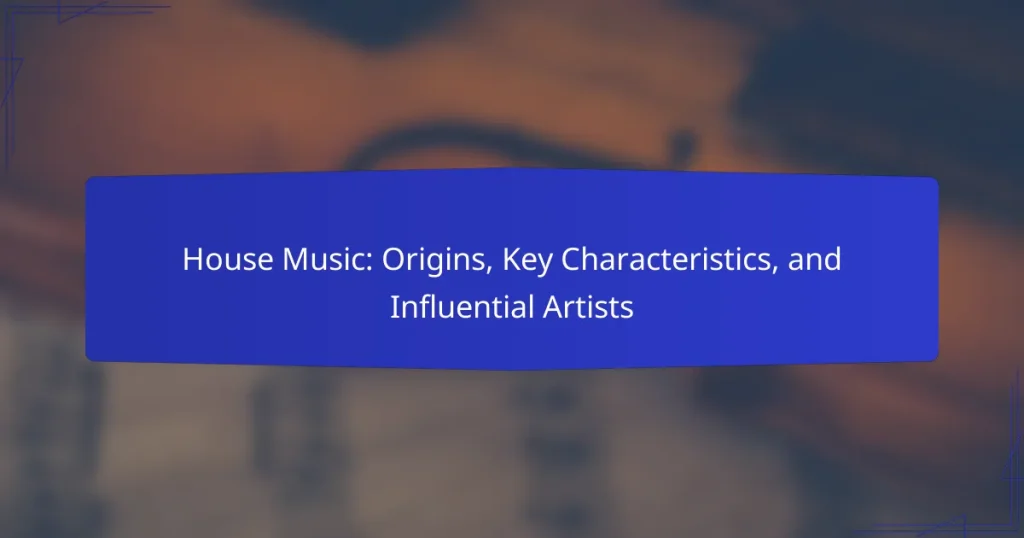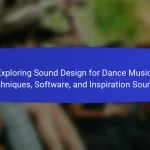House music is a genre of electronic dance music that originated in the early 1980s in Chicago, characterized by repetitive 4/4 beats and synthesized basslines, often incorporating elements from disco, funk, and soul. The genre has various subgenres, including deep house, acid house, and progressive house, and has significantly influenced global nightlife and music festivals. Key artists such as Frankie Knuckles, Larry Heard, and David Morales have played pivotal roles in shaping house music’s evolution and mainstream acceptance. Engaging with house music involves active listening, attending live events, exploring subgenres, and connecting with online communities to deepen appreciation and involvement.
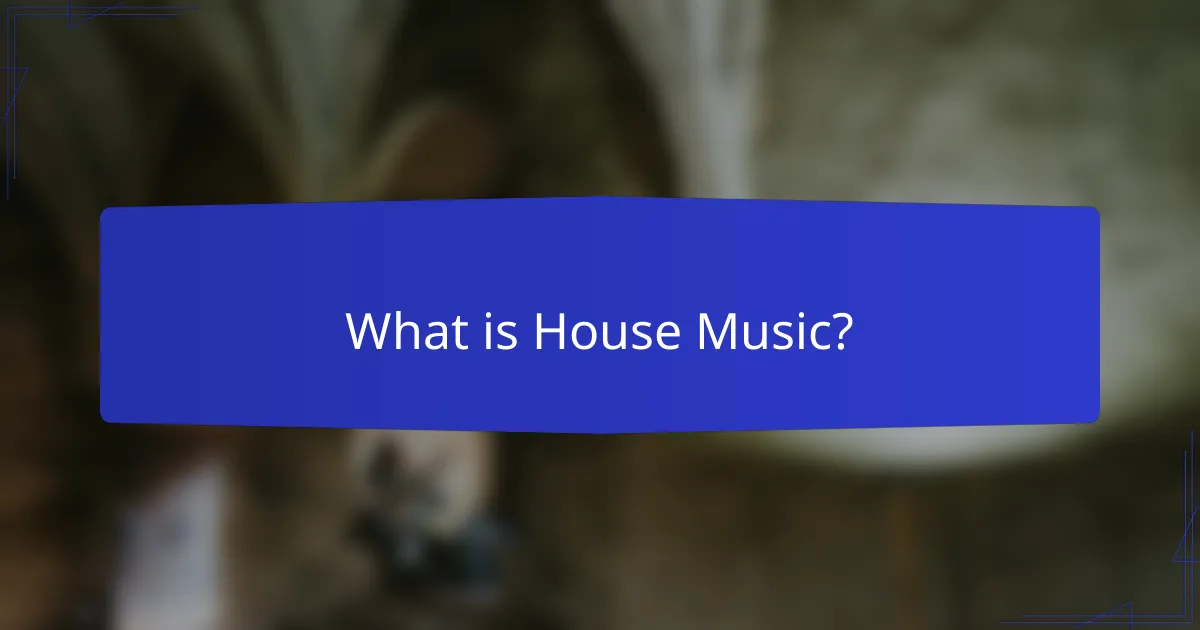
What is House Music?
House music is a genre of electronic dance music that originated in the early 1980s. It emerged from Chicago’s club scene and is characterized by repetitive 4/4 beats and synthesized basslines. House music often incorporates elements from disco, funk, and soul. The genre gained popularity in dance clubs and has influenced numerous other music styles. Notable subgenres include deep house, acid house, and progressive house. House music has a significant cultural impact, shaping nightlife and music festivals worldwide. Its widespread appeal can be attributed to its infectious rhythms and accessibility for DJs and producers.
How did House Music originate?
House music originated in the early 1980s in Chicago. It emerged from the disco scene, blending elements of electronic music and funk. Key figures like Frankie Knuckles and Larry Heard played pivotal roles in its development. The genre was characterized by repetitive beats and synthesized melodies. House music gained popularity in underground clubs and eventually spread globally. By the mid-1980s, it influenced various music styles and cultures. The genre’s name derives from the Warehouse club, where Knuckles was a resident DJ. House music continues to evolve, impacting contemporary electronic dance music.
What cultural influences shaped the beginnings of House Music?
House music emerged from a blend of cultural influences primarily rooted in African American, Latino, and [censured] communities in Chicago during the early 1980s. The genre drew heavily from disco, which provided a rhythmic foundation and a dance-oriented ethos. Additionally, the use of synthesizers and drum machines reflected the technological advancements of the time.
The influence of soul and funk music can also be seen, as these genres contributed to the emotive vocal styles and bass lines in house tracks. The Chicago club scene, particularly venues like the Warehouse, played a crucial role in popularizing house music, fostering a sense of community and expression.
Moreover, the cultural backdrop of the post-disco era, characterized by economic challenges and social change, shaped the sound and message of house music. This genre became a form of escapism and celebration for marginalized groups, solidifying its roots in the cultural landscape of the time.
How did the Chicago club scene contribute to the rise of House Music?
The Chicago club scene was instrumental in the rise of House Music. In the late 1970s and early 1980s, clubs like The Warehouse and The Music Box became hubs for this emerging genre. DJs such as Frankie Knuckles and Ron Hardy played a vital role in shaping the sound. They mixed disco, soul, and electronic music to create a unique experience. The use of drum machines and synthesizers defined the genre’s sound. This innovative mixing attracted diverse crowds and fostered a sense of community. The popularity of these clubs helped spread House Music beyond Chicago. By the mid-1980s, it gained international recognition, influencing dance music worldwide.
What are the key characteristics of House Music?
House music is characterized by its repetitive 4/4 beat, synthesized melodies, and basslines. The tempo typically ranges from 120 to 130 beats per minute. House music often features vocal samples, either from disco tracks or original recordings. The genre incorporates elements from various styles, including funk, soul, and jazz. It emphasizes a strong kick drum and hi-hat patterns. House music is known for its use of synthesizers and drum machines. The genre promotes a sense of community and dance culture. Its origins can be traced back to the early 1980s in Chicago clubs.
What are the defining musical elements of House Music?
House music is characterized by its repetitive 4/4 beat, syncopated basslines, and synthesized melodies. The tempo typically ranges from 120 to 130 beats per minute. Kick drums are prominent, providing a steady pulse. Hi-hats and claps add rhythmic texture. House music often incorporates soulful vocals and samples from disco and funk genres. It utilizes synthesizers to create rich, layered sounds. The genre emphasizes groove and danceability, making it popular in clubs. These elements collectively define the unique sound of house music.
How does the tempo and rhythm differentiate House Music from other genres?
House music is characterized by a steady tempo and distinctive rhythm that sets it apart from other genres. Typically, house music features a tempo ranging from 120 to 130 beats per minute. This consistent tempo creates a danceable groove that is essential for club settings. The rhythm in house music often includes a four-on-the-floor beat, where the bass drum hits on every beat. This pattern contrasts with genres like rock or jazz, which may have more varied rhythms. Additionally, house music incorporates syncopation and off-beat hi-hats, adding complexity to its sound. These rhythmic elements contribute to a hypnotic feel, encouraging prolonged dancing. The combination of tempo and rhythm in house music fosters an immersive experience for listeners and dancers alike.
What subgenres exist within House Music?
House music includes several subgenres. Notable subgenres are Deep House, Tech House, and Progressive House. Deep House is characterized by its soulful vocals and complex melodies. Tech House blends elements of techno and house, focusing on rhythm and minimalism. Progressive House features build-ups and breakdowns, often creating an emotional journey. Other subgenres include Acid House, which incorporates acid synths, and Chicago House, the genre’s origin. Each subgenre has unique attributes that differentiate it within the broader house music category.
What are the unique traits of Deep House?
Deep House is characterized by its smooth, soulful sound and complex melodies. It often features deep basslines and soft, atmospheric synths. The tempo usually ranges from 120 to 125 BPM. Vocals in Deep House are often soulful and emotive. The genre emphasizes a laid-back vibe, suitable for relaxed environments. It incorporates elements from jazz, funk, and soul music. Deep House tracks often use repetitive structures, creating a hypnotic effect. Notable artists like Larry Heard and Kerri Chandler have significantly influenced its development.
How does Tech House differ from traditional House Music?
Tech House differs from traditional House Music primarily in its sound and structure. Tech House incorporates elements from techno, resulting in a more minimalistic and groove-oriented style. Traditional House Music typically features more soulful melodies and vocal samples. The tempo of Tech House often ranges from 120 to 130 BPM, while traditional House Music generally stays around 120 BPM. Tech House emphasizes repetitive beats and synthesized sounds, creating a hypnotic effect. In contrast, traditional House often includes live instrumentation and more complex chord progressions. This distinction highlights the evolution of House Music into various sub-genres, with Tech House emerging in the 1990s as a fusion of styles.
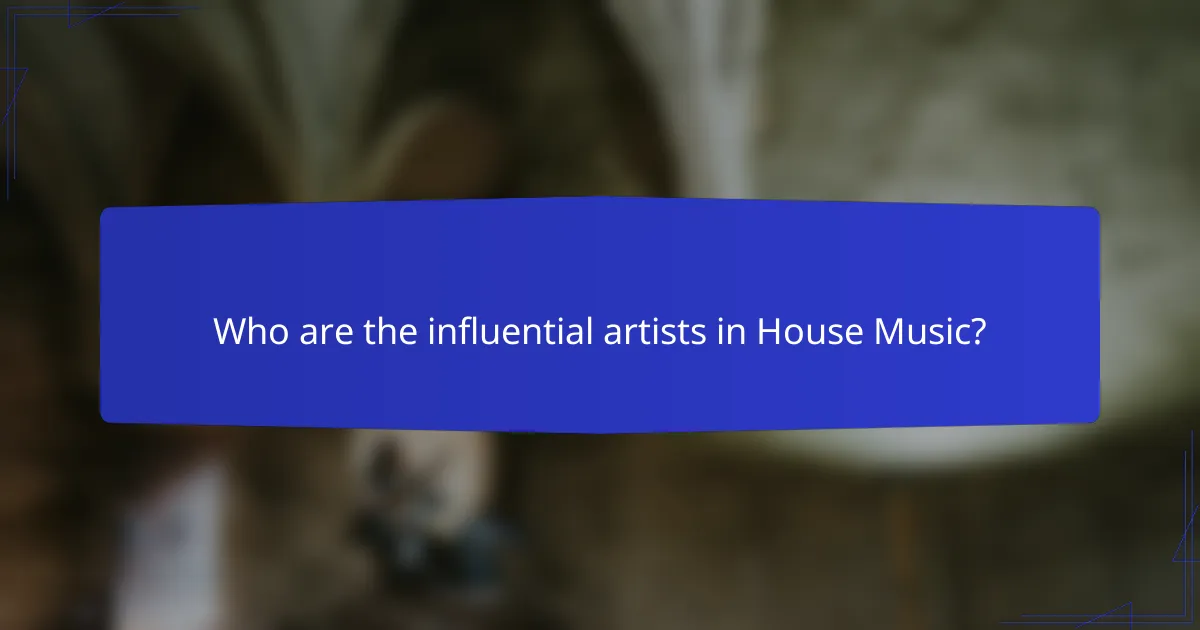
Who are the influential artists in House Music?
Influential artists in House Music include Frankie Knuckles, known as the “Godfather of House.” His work in the 1980s helped define the genre. Another key figure is Larry Heard, who introduced deep house sounds. His tracks like “Can You Feel It” are iconic. David Morales is also significant, known for his remixing skills and productions. He contributed to the mainstream acceptance of house music. Other notable artists include Todd Terry, who blended house with hip-hop elements, and Daft Punk, who brought house music to a wider audience with their unique style. Each artist played a vital role in shaping house music’s evolution and popularity.
What contributions have key artists made to House Music?
Key artists have significantly shaped House Music through innovation and influence. Frankie Knuckles, known as the ‘Godfather of House,’ pioneered the genre in Chicago during the 1980s. He introduced soulful elements and remixing techniques that defined early House tracks. Larry Heard, another pivotal figure, blended deep house with jazz influences, creating a unique sound that remains influential.
Masters at Work, consisting of Louie Vega and Kenny Dope, contributed by merging Latin rhythms with House, expanding its global appeal. Daft Punk revolutionized House with their electronic sound, incorporating funk and disco elements, which brought the genre into mainstream culture.
These artists’ contributions established foundational styles and techniques that continue to resonate in modern House Music. Their work has influenced countless producers and DJs, ensuring House Music’s evolution and relevance over the decades.
How did Frankie Knuckles influence the genre’s development?
Frankie Knuckles significantly influenced the development of house music. He is often referred to as the “Godfather of House Music.” Knuckles played a crucial role in popularizing the genre in the 1980s. His work at the Warehouse club in Chicago helped define the sound of house music. He blended disco, soul, and electronic music elements. This fusion created a unique sound that resonated with audiences. His remixes and productions, such as “Your Love” and “Baby Wants to Ride,” became foundational tracks. Knuckles’ innovative use of sampling and drum machines shaped the genre’s production techniques. His influence extended globally, inspiring countless artists and DJs in the electronic music scene.
What impact did Daft Punk have on the global perception of House Music?
Daft Punk significantly elevated the global perception of House Music. Their unique sound blended house with elements of disco and electronic music. This fusion attracted a broader audience beyond traditional house music fans. The release of their album “Homework” in 1997 marked a pivotal moment in electronic music. Tracks like “Around the World” showcased catchy hooks and innovative production techniques. Daft Punk’s visually striking performances and iconic robot personas contributed to their mystique. They received critical acclaim and commercial success, influencing countless artists. Their impact is evident in the mainstream acceptance of house and electronic music today.
Which contemporary artists are shaping the future of House Music?
Contemporary artists shaping the future of House Music include Black Coffee, Peggy Gou, and Fisher. Black Coffee is known for his deep house sound and global influence. He has garnered international acclaim and collaborations with major artists. Peggy Gou blends house with techno and has a unique style that resonates widely. She has gained a significant following and performs at major festivals. Fisher is recognized for his catchy tracks and energetic performances. His hit “Losing It” topped charts and brought him mainstream attention. These artists are redefining House Music through innovation and cross-genre collaborations.
What innovations are artists like Fisher bringing to House Music?
Artists like Fisher are innovating House Music by integrating unique sound design and catchy vocal samples. Fisher’s track “Losing It” exemplifies this with its infectious hook and driving bassline. He utilizes advanced production techniques, such as sidechain compression, to create a dynamic sound. His approach emphasizes rhythm and groove, making tracks more danceable. Fisher also incorporates elements from other genres, like techno and pop, broadening the appeal of House Music. This fusion attracts a diverse audience and revitalizes the genre. The success of his tracks in clubs and festivals showcases the effectiveness of these innovations.
How are emerging artists redefining House Music in the digital age?
Emerging artists are redefining House Music in the digital age through innovative production techniques and diverse influences. They utilize digital platforms to distribute their music, reaching global audiences instantly. This accessibility allows for collaboration across genres, blending elements of hip-hop, pop, and electronic music.
New technologies enable artists to experiment with sound design, creating unique textures and rhythms. Social media serves as a powerful tool for promotion and community building. Live streaming performances have become popular, allowing artists to connect with fans in real-time.
Data from Spotify shows that House Music streams have increased significantly, indicating its growing popularity. Emerging artists are also leveraging platforms like SoundCloud and Bandcamp to share their work independently. This shift empowers them to maintain creative control and engage directly with their audience.
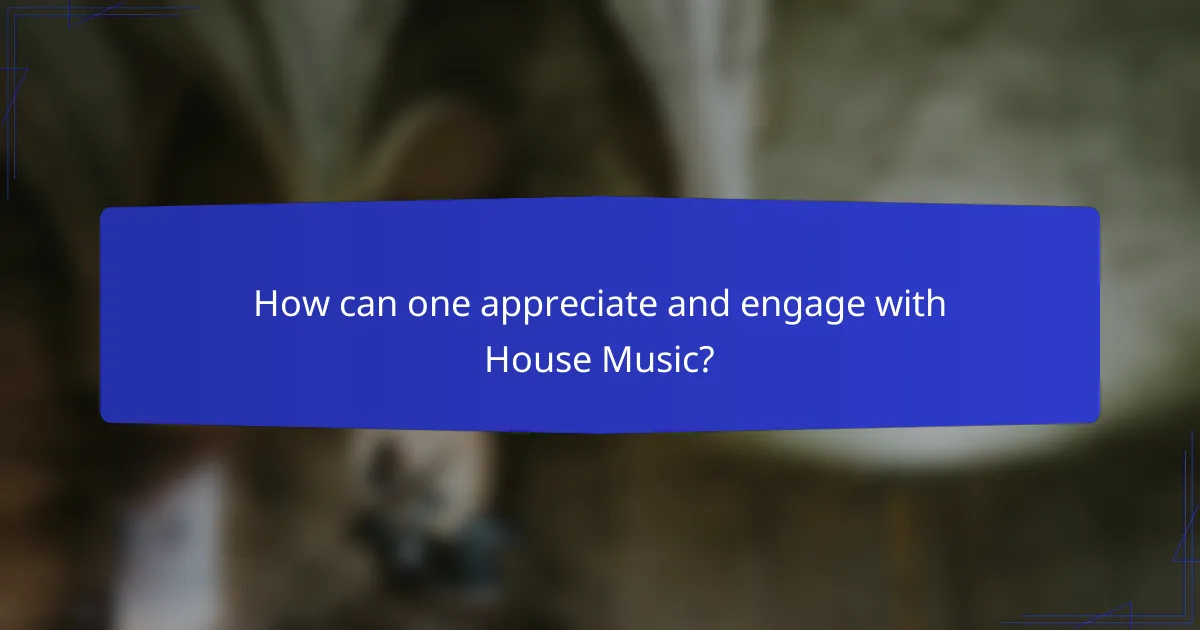
How can one appreciate and engage with House Music?
To appreciate and engage with House Music, one should actively listen to its distinct rhythms and beats. Understanding its origins in the Chicago club scene enhances appreciation. Attending live performances or club events allows for immersive experiences. Exploring various subgenres, like Deep House or Acid House, broadens engagement. Connecting with online communities fosters discussions and shared insights. Creating playlists of favorite tracks helps in discovering new artists. Learning about influential artists, such as Frankie Knuckles and Larry Heard, provides historical context. Finally, experimenting with mixing or producing music can deepen personal involvement.
What are the best practices for enjoying House Music?
To enjoy House Music effectively, immerse yourself in the genre’s rhythm and energy. Attend live events or parties where House Music is played to experience the atmosphere. Engaging with the community enhances enjoyment, as shared experiences amplify the music’s impact. Create playlists featuring a variety of House Music sub-genres to explore its diversity. Listening through high-quality speakers or headphones improves sound quality and appreciation. Understanding the history and evolution of House Music enriches your listening experience. Familiarize yourself with influential artists and their signature styles for deeper appreciation. Finally, dance and move to the music; physical engagement enhances enjoyment and connection to the beats.
How can one create a House Music playlist for different moods?
To create a House Music playlist for different moods, first identify the mood you want to evoke. For upbeat and energetic vibes, select tracks with a fast tempo and strong basslines. Songs like “I Feel for You” by Bob Sinclar can enhance a lively atmosphere. For relaxation, choose smoother, deeper house tracks with mellow melodies. “Can’t Get Enough” by Soulsearcher fits this category well. If aiming for a romantic mood, incorporate soulful vocals and softer rhythms. Tracks like “Finally” by Kings of Tomorrow work effectively here. For introspective moments, opt for deeper house with atmospheric elements. “Deep End” by John Summit can set the right tone. Tailor your playlist by mixing these styles to reflect various moods.
What are the benefits of attending House Music events and festivals?
Attending House Music events and festivals provides numerous benefits. These events foster a sense of community among attendees. Participants often form connections with like-minded individuals who share a passion for the genre. House Music events also offer an immersive experience with high-quality sound and lighting. This enhances the overall enjoyment of the music.
Moreover, live performances by renowned DJs create an electrifying atmosphere. Attendees can witness unique interpretations of tracks in real-time. Additionally, these events often feature diverse lineups, exposing attendees to new artists and sounds. This broadens their musical horizons.
According to a study by the University of Leeds, attending music festivals can improve mental well-being. The findings suggest that shared musical experiences can lead to increased happiness and reduced stress. Thus, attending House Music events not only entertains but also promotes emotional health.
What resources are available for learning more about House Music?
Books on house music include “Last Night a DJ Saved My Life” by Bill Brewster and Frank Broughton. This book provides a comprehensive history of DJ culture and house music. Online platforms like YouTube offer tutorials and documentaries about house music’s evolution. Websites such as Resident Advisor and Mixmag feature articles and interviews with influential artists. Music streaming services often have curated playlists highlighting key house tracks. Courses on platforms like MasterClass cover music production and genre-specific techniques. Local music schools frequently offer classes on electronic music and DJing. These resources collectively enhance understanding of house music’s origins and its key characteristics.
Which platforms offer the best House Music mixes and tracks?
Spotify, SoundCloud, and Mixcloud offer the best House Music mixes and tracks. Spotify features curated playlists and algorithm-driven recommendations. SoundCloud allows independent artists to upload their mixes and tracks. Mixcloud specializes in long-form mixes and DJ sets. These platforms have extensive libraries and user-friendly interfaces. They also support community engagement through comments and sharing. Many popular House Music artists release their work on these platforms. This accessibility enhances the discovery of new tracks and mixes.
How can one find local House Music events and communities?
To find local House Music events and communities, one can use social media platforms. Websites like Facebook and Instagram often feature event listings. Local event aggregators and community boards also provide information on upcoming shows. Additionally, music streaming platforms may have event sections for local artists. Popular apps like Meetup can connect users with House Music enthusiasts. Local clubs and venues typically advertise events on their websites. Engaging with local DJs and producers can lead to discovering underground events. Networking within the community enhances the chances of finding exclusive gatherings.
House music is a genre of electronic dance music that originated in the early 1980s in Chicago, characterized by repetitive 4/4 beats, synthesized basslines, and influences from disco, funk, and soul. The article explores the origins of house music, its cultural influences, and the pivotal role of the Chicago club scene in its development. Key characteristics, subgenres, and influential artists such as Frankie Knuckles and Daft Punk are also examined, highlighting their contributions to the genre’s evolution and global popularity. Additionally, the article discusses contemporary artists shaping the future of house music and offers insights on engaging with the genre through events, playlists, and resources.
